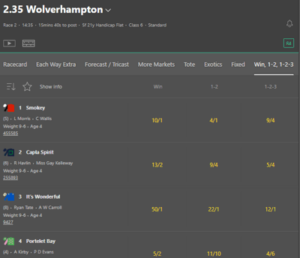 Bookmakers exist in an extremely competitive market. They are always trying to come up with ways to get one over on one another in the sense of winning customers, exploring different bet types to persuade punters to place their wagers with them instead of their competitors. One such example a relatively new market is the 1-2 bet, sometimes even being stretched to be a 1-2-3 bet. In essence, it’s a bit like an Each-Way wager, but instead of having to pay double the stake, punters are offered lower odds for a win in a single bet.
Bookmakers exist in an extremely competitive market. They are always trying to come up with ways to get one over on one another in the sense of winning customers, exploring different bet types to persuade punters to place their wagers with them instead of their competitors. One such example a relatively new market is the 1-2 bet, sometimes even being stretched to be a 1-2-3 bet. In essence, it’s a bit like an Each-Way wager, but instead of having to pay double the stake, punters are offered lower odds for a win in a single bet.
To put it another way, where an Each-Way bet would ask you to pay double the stake and essentially break your bet up into two bets, one for a Win and one for a Place, 1-2 bets look to keep things simple and only take one stake but pay out on a similar number of places. If your chosen horse finishes first or second, or first, second or third if you opt for a 1-2-3 bet, then your wager will be a winner. It allows you to put your entire stake on the horse doing what you want it to, rather than splitting your stake in half.
How 1-2 Bets Work
 If you feel hugely confident about the selection that you’ve made winning the horse race that you’re betting on, it makes sense to place a wager on the straight Win option. In a lot of cases, however, people are not all that confident that their selection will do what they want it to do. When this is the case, they toy with placing an Each-Way bet instead of a Win one, simply because this gives them a little bit of cover if their horse slightly underperforms and ends up just missing out on the top spot, finishing in the places instead.
If you feel hugely confident about the selection that you’ve made winning the horse race that you’re betting on, it makes sense to place a wager on the straight Win option. In a lot of cases, however, people are not all that confident that their selection will do what they want it to do. When this is the case, they toy with placing an Each-Way bet instead of a Win one, simply because this gives them a little bit of cover if their horse slightly underperforms and ends up just missing out on the top spot, finishing in the places instead.
An alternative to an Each-Way bet is the 1-2 wager, which can usually be found as an alternative market on a bookmaker’s page. It is essentially the same as taking out an Each-Way wager that only pays if your horse finishes first or second, or first, second or third in the case of those that opt for the 1-2-3 bet. The big different is that it remains one wager, rather than being split into two bets. The reason this is good news is that it only requires one stake, with the bookie making their money by offering lower odds.
Another option for punters is a cover bet, again you accept lower odds overall but here this pays out if you win and gives you your stake back if the horse places. You can often choose the number of places you want to cover.
Examples
The best way of explaining the 1-2 bet is by looking at a specific example or two. Here is a look at how the odds worked for a flat race that took place at Newcastle, giving you the odds for a straight Win bet, a 1-2 bet or a 1-2-3 bet, which you’ll note decrease depending on which of the options you go for. To keep things simple, we’ll look at the odds of five horses:
| Horse | Win Odds | 1-2 Odds | 1-2-3 Odds |
|---|---|---|---|
| Ustath | 13/2 | 5/2 | 13/8 |
| Mr Trevor | 4/1 | 2/1 | 5/4 |
| Champagne Supanova | 9/2 | 2/1 | 5/4 |
| Kolossus | 18/1 | 13/2 | 4/1 |
| Independent Beauty | 40/1 | 20/1 | 12/1 |
The odds diminish the more places you want to paid out on, which makes perfect sense given the more chance there is that the bookmaker in question will end up having to pay out if it finishes third. You can see that the odds almost halve when you move from a straight Win bet to a 1-2 wager, shifting down again when you extend it out to being a 1-2-3 bet.
Now let’s have a look at the same thing for a different race, just to give you a real sense of how it works. These are the odds for five horse taking part in a Grade 3 Handicap Hurdle event at Haydock Park, once again looking at the Win, 1-2 and 1-2-3 markets for a fair sense of comparison:
| Horse | Win Odds | 1-2 Odds | 1-2-3 Odds |
|---|---|---|---|
| If The Cap Fits | 16/1 | 7/1 | 4/1 |
| Brinkley | 18/1 | 8/1 | 9/2 |
| Ask Dillon | 25/1 | 12/1 | 7/1 |
| Stoney Mountain | 16/1 | 7/1 | 4/1 |
| Storm Arising | 28/1 | 14/1 | 8/1 |
As with the race at Newcastle, you can see that the odds all but halve if not more when you opt for the 1-2 odds over placing a bet to Win, dropping by a similar amount when you look at the 1-2-3 market.
Is It Good Value?
 The obvious question to ask is whether or not placing a 1-2 or 1-2-3 bet is good value for money. Let’s look at one example from the above horses to give us a sense of where we lie on that front. Let us presume that we’ve placed our wager with a bookmaker that pays out at quarter odds for the Each-Way part of an Each-Way bet, paying to three places. We’ll use Mr Trevor as our example because of the simplicity of the maths on a horse with relatively low odds. A £20 Each-Way bet would work out as follows:
The obvious question to ask is whether or not placing a 1-2 or 1-2-3 bet is good value for money. Let’s look at one example from the above horses to give us a sense of where we lie on that front. Let us presume that we’ve placed our wager with a bookmaker that pays out at quarter odds for the Each-Way part of an Each-Way bet, paying to three places. We’ll use Mr Trevor as our example because of the simplicity of the maths on a horse with relatively low odds. A £20 Each-Way bet would work out as follows:
- £10 on Win at odds of 4/1
- £10 on Each-Way at odds of 1/1
A Win would result in a return of £70 if the horse came first, which is made up of £40 from the Win part of the bet, £10 from the Each-Way part and the £20 stake being returned to us. Here’s how it would work out if you placed £20 on either the 1-2 odds or the 1-2-3 option:
- £20 on 1-2 at odds of 2/1 = £60 returned
- £20 on 1-2-3 at odds of 5/4 = £45 returned
Obviously the Each-Way bet works out better if the horse wins. The question is, what happens if the horse only manages to place? You’ll lose the Win part of the Each-Way bet, meaning that your only return is the Place part of the wager. Now the amount that you’d get returned to you is £20, which is made up of £10 stake and £10 payout. That means that you’ve simply covered your losses and made no profit, whereas you’ll have made a £40 profit on the 1-2 market and a profit of £25 on the 1-2-3 option.
Looking At All Payouts
Now that we understand the difference in payout between an Each-Way and a 1-2 or 1-2-3 bet, let’s have a look at how much you could expect to be paid on all ten of the above horses, complete with the odds you’d be betting with. For the purposes of this, we’re going to assume that your horse winning the race would see you paid more for an Each-Way bet, instead imagining that your selection finished second in the race each time. We’re also going to imagine a total stake of £20, either as £10 Each-Way or £20 on the nose, bet depending:
| Horse Name | Each-Way Odds & Payout | 1-2 Odds & Payout | 1-2-3 Odds & Payout |
|---|---|---|---|
| Ustath | 13/2 – £26.25 | 5/2 – £70 | 13/8 – £52.50 |
| Mr Trevor | 4/1 – £20 | 2/1 – £60 | 5/4 – £45 |
| Champagne Supanova | 9/2 – £21.25 | 2/1 – £60 | 5/4 – £45 |
| Kolossus | 18/1 – £55 | 13/2 – £150 | 4/1 – £100 |
| Independent Beauty | 40/1 – £110 | 20/1 – £420 | 12/1 – £260 |
| If The Cap Fits | 16/1 – £50 | 7/1 – £160 | 4/1 – £100 |
| Brinkley | 18/1 – £55 | 8/1 – £180 | 9/2 – £110 |
| Ask Dillon | 25/1 – £72.50 | 12/1 – £260 | 7/1 – £160 |
| Stoney Mountain | 16/1 – £50 | 7/1 – £160 | 4/1 – £100 |
| Storm Arising | 28/1 – £80 | 14/1 – £300 | 8/1 – £180 |
As you can see, it always makes sense to place a bet on the Each-Way market if you are confident that the horse that you’re betting on is going to win but want to give yourself a little bit of leeway just in case things don’t work out. The 1-2 and 1-2-3 markets, on the other hand, are the best option if you think that you’re horse is unlikely to win but will be in and around the places.
Why Place It
 Now that we know whether or not it is worth placing a 1-2 or 1-2-3 bet, the next question becomes why you’d want to do so. The answer comes in the form of the confidence that you’ve got in your selection to actually win the race. If you think it’s a nailed on winner, there’s no point in opting for either an Each-Way or a 1-2 bet, instead plumping all of your money on the Win market. If, however, you’re not sure that the horse that you’ve chosen has got the ability to go all the way to the finish line then that’s when an alternative is worth it.
Now that we know whether or not it is worth placing a 1-2 or 1-2-3 bet, the next question becomes why you’d want to do so. The answer comes in the form of the confidence that you’ve got in your selection to actually win the race. If you think it’s a nailed on winner, there’s no point in opting for either an Each-Way or a 1-2 bet, instead plumping all of your money on the Win market. If, however, you’re not sure that the horse that you’ve chosen has got the ability to go all the way to the finish line then that’s when an alternative is worth it.
Only you will know why you chose the horse that you’ve chosen and how confident you are in its ability to finish as the winner. Once you’ve allowed a seed of doubt to creep in, however, it’s clear that there is better value in opting for the 1-2 or even the 1-2-3 market. Not only will it see you get a higher payout but it will also give you more chance of actually winning said pay out. Of course, the downside comes if it finishes fourth, which an Each-Way bet would have at least seen you get your money back over but even a 1-2-3 bet wouldn’t.
